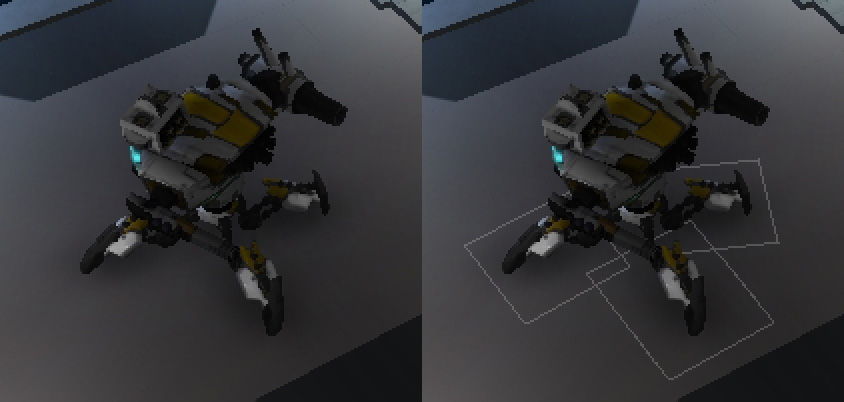Difference between revisions of "Decal"
(→Tutorials) |
EricChadwick (Talk | contribs) (depth offset, gbuffer) |
||
| Line 1: | Line 1: | ||
| − | A texture with [[Opacity map|transparency]] on a floating polygon, so that it appears to be painted directly on the underlying mesh. | + | A texture with [[Opacity map|transparency]] on a floating polygon, so that it appears to be painted directly on the underlying mesh. Decals are commonly used for effects such as bullet marks, graffiti, broken edges, and tire tracks. |
| − | For hard-edged decals use "[[Transparency map#Alpha_Test|alpha test]]" because this is usually cheaper to render. If the decals must be softer (tire tracks in a racing game) then use [[Transparency map#Alpha_Blend|alpha blend]] instead. | + | When placing decals, care must be taken to avoid [[Z-Fighting]]. However if you use a shader with depth offset this completely avoids Z-fighting. |
| + | |||
| + | To only influence normals of the underlying surface, use deferred rendering and a shader with per-channel GBuffer mixing. See [http://www.polycount.com/forum/showpost.php?p=2357033&postcount=38 Decal technique from Star Citizen]. | ||
| + | |||
| + | For hard-edged decals use "[[Transparency map#Alpha_Test|alpha test]]" because this is usually cheaper to render. If the decals must be softer (tire tracks in a racing game) then use [[Transparency map#Alpha_Blend|alpha blend]] instead. See also [[MultiTexture]]. | ||
Another common use is for blob shadows, which are soft dark circles under a model. Blob shadows are usually faster to render than using shadow-casting lights, and can replicate the look of soft shadowing. | Another common use is for blob shadows, which are soft dark circles under a model. Blob shadows are usually faster to render than using shadow-casting lights, and can replicate the look of soft shadowing. | ||
Latest revision as of 19:22, 1 October 2015
A texture with transparency on a floating polygon, so that it appears to be painted directly on the underlying mesh. Decals are commonly used for effects such as bullet marks, graffiti, broken edges, and tire tracks.
When placing decals, care must be taken to avoid Z-Fighting. However if you use a shader with depth offset this completely avoids Z-fighting.
To only influence normals of the underlying surface, use deferred rendering and a shader with per-channel GBuffer mixing. See Decal technique from Star Citizen.
For hard-edged decals use "alpha test" because this is usually cheaper to render. If the decals must be softer (tire tracks in a racing game) then use alpha blend instead. See also MultiTexture.
Another common use is for blob shadows, which are soft dark circles under a model. Blob shadows are usually faster to render than using shadow-casting lights, and can replicate the look of soft shadowing.

Tutorials

Using Decals for Destroyed Structures - from the CryENGINE Art Asset Creation Guide - Using alpha blended decals for broken concrete edges.

Broken concrete for CE3 (Tutorial) - by Valdemar 'sltrOlsson' Nyhlén - Video tutorials using Zbrush and Maya to generate tiled maps for broken concrete edges.

Fallout 3 – Edges from Simon Schreibt - Investigating decal usage in Fallout 3.

Decal technique from Star Citizen - By Kristóf 'Obscura' Lovas - Text based tutorial for creating decals in "Star Citizen style", and using them in Unreal Engine.